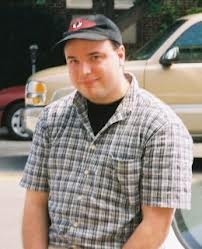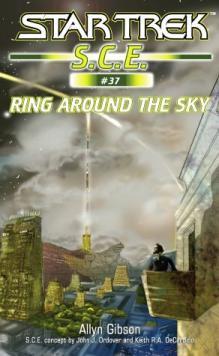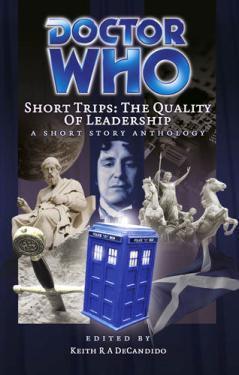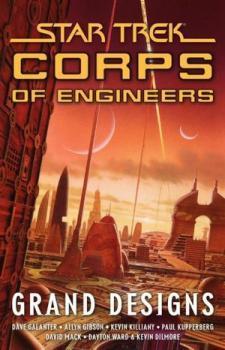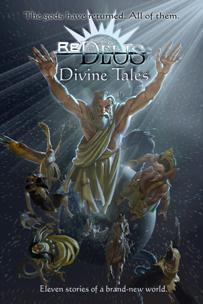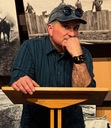Author Interview: Allyn Gibson
What do you get when you cross a Star Trek fan with a Doctor Who fan with a Beatles fan with a baseball fan who also likes museums and hiking? You get fiction and media tie-in writer, Allyn Gibson. Allyn also writes for PREVIEWS, Diamond Comic Distributor's monthly catalog. Find out how Allyn's love of baseball found its way into his contribution to the anthology, ReDeus: Divine Tales...
First, tell us where we can find you online.
I'm very easy to find online. I have a blog at allyngibson.net that I've been maintaining for over ten years now. I have a LiveJournal account (tiggerallyn) that mirrors my blog. I'm also on Twitter (handle: allyngibson) and Facebook. I'm not on Tumblr yet, though I have set up an account (again, allyngibson).
I used to make a blog post every day, but in the last year I've gotten away from that for several reasons. After a decade, I sometimes wonder what more there is to say. Also, there doesn't seem to be a blog readership any more; the kind of personal blogging that was common five years ago (“Here's what I did today,” “Here's what I had for lunch,” that kind of thing) has all but vanished as people have moved that kind of content over to Twitter and Facebook.
This realization has prompted a rethink of what I'm trying to accomplish with my site, so I'm developing a new site that combines a professional “This is who I am, this is what I do, this is what I write” site with a journal-esque blog site. The site design I have now is almost there, but it's clunky because that's not what it was designed for. I have to decide what gets featured, I have to remember what goes where, I'm locked into some kludgey design choices, and content gets lost easily.
What I'm developing now automates the content flow. Blog-type content doesn't get lost, and I've made it much easier for my professional content to come to the fore. While I've done WordPress development in the past, what I'd doing now is beyond anything I've done before.
Longtime readers of my blog will know that I've said in the past that I'm “close to completion” on this redesign since last October, but because I've been pushing myself to learn more about WordPress, even though I've been using it for eight years now, I'll find new and better ways of accomplishing something which results in scrapping work I've done. In many ways, coding this site is like redrafting a novel; I know what I want to achieve, and I have to work out the best way to achieve those goals.
The last summit to climb is Responsive Design – making a site that functions well and looks good on mobile devices and tablets.
The new site probably won't launch until the new year. Migrating ten years and thousands of blog posts won't happen overnight. I'm also planning to launch a podcast with the site relaunch.
Before publishing Star Trek stories with Pocket Books, did you write any fan fiction in the Trek universe or otherwise?
My mom keeps a notebook that I had when I was in fourth grade. In that notebook, there's a story that's set in the world of Arthur C. Clarke's 2010. It would have been in the early 80s that I wrote this, and when I was nine and ten years-old, I wanted the story that led us from the world as it was to the world that was Clarke's. The writings involved Heywood Floyd, and it was illustrated with drawings of space shuttles in orbit working on building the Discovery. That notebook, and a Sherlock Holmes story called “Murder at the Metropolitan Club,” would have been among my earliest stories – and they're both clearly fanfic.
I didn't write much in the way of Star Trek fan fiction as a young writer. In high school, the fan fiction I wrote was set in the world of Isaac Asimov's Robots/Foundation universe. There were two ideas I wanted to explore in these stories. First, how were the Spacer worlds settled and why did they rebel against Earth? Second, were there ever any robots built without the Three Laws. The main character in these stories was a humaniform robot named R.J. Washington who was a secret agent for Earth during the Spacer rebellion. They were inspired as much by the Robot City novels that were being published at the time as they were by Asimov's original work.
I dabbled with Star Trek fan fiction occasionally. The one that stands out was a story called “Foundation and Federation” that brought Data and R. Daneel Olivaw together because I thought that would be cool. In college I wrote spec scripts for Star Trek: Deep Space Nine and Star Trek: Voyager (one of each) and sent them off to the production offices. When the Strange New Worlds contest started, I began submitting Star Trek stories to that, but none were ever bought. To be frank, none of those stories were any good, though I did pilfer some of the ideas from one of the Strange New Worlds stories for my Star Trek: SCE novella, Ring Around the Sky. There were good ideas in some of these stories – comets covered with Dyson trees, the return of the Moriarty hologram as a computer virus, doomsday weapons set in motion centuries earlier when interstellar wars were conducted at sublight speeds – but the execution was poor.
How did you come to write for the Doctor Who anthology, Short Trips: The Quality of Leadership (Big Finish, May 2008)? Can you give us fellow Who fans a blurb about your story, “The Spindle of Necessity”?
I received an e-mail from Keith DeCandido one evening. He was putting together a Doctor Who anthology for Big Finish Productions, and he wanted to know if I wanted to pitch a story for it. The anthology was going to be about the Doctor's encounters with leaders, and I wrote back and said I'd love to be a part of it. I wrote out a couple of ideas that night, but the idea that I pitched to Keith came to me at about 4 o'clock the next morning. It quite literally woke me from a dead sleep, and I jotted down the ideas that roused me before I lost them. A few hours later, after the alarm went off, I did some rudimentary Wikipedia research to see if the idea would work, I saw that it did, and I sent my pitch off to Keith.
In “The Spindle of Necessity,” the sixth Doctor (he of the coat of many colors and the abrasive personality) meets the Greek philosopher Plato. The Doctor is running for his life – he's been put on trial by the Time Lords and he's seen a dark vision of his future. Plato is running from Athens – his teacher Socrates has been executed, and he's searching for some meaning to life. They meet in a bazaar in Egypt, and Plato tells the Doctor of his mad quest to find the Spindle of Necessity – the axis on which the world turns, which one can ascend to reach the heavens and meet the gods. Plato believes the Earth is the center of the universe, that the sun and the stars revolve around it. The Doctor knows this is madness, and together they embark on a very strange journey. It may just be that Plato – and not the Doctor – is right.
And it's written like a lost Socratic dialogue.
It's a very strange story, if you can't tell from that description. It drove me almost around the bend while writing it. I had a very specific vision for the story, with certain beats I wanted to hit, a gentle, light-hearted sort of thing like Fritz Leiber's “Lean Times in Lankhmar,” but I couldn't make that vision of the story work. Writing it as a dialogue was a last resort, and I tried it, honestly, because I had the deadline staring me in the face. I thought it was such a crazy idea that Keith would find the form of the story unacceptable and he'd give me a month's extension to make the story work. The dialogue, all 12,000 words, was written in two days. Keith loved it. He had me cut two thousand words from it, but otherwise it was fine. The lesson? Sometimes, you really should listen to the crazy ideas in your head. That crazy voice has good instincts.
I was really honored when it was chosen for reprint in Big Finish's “Best Of” anthology, Re:Collections.
You and I both have stories in the anthology, ReDeus: Divine Tales (Crazy 8 Press, August 2012). What inspired your story, “The Ginger Kid”?
When Bob Greenberger approached me about pitching a story for ReDeus, the first thing I did was to say “Yes” even though I had absolutely no ideas at all. I read his pitch document, and I was intrigued. At work, the day that I received the pitch invitation, I kept a notepad on my desk and I jotted down ideas throughout the morning. The first idea I had, which was a pretty good idea, was wholly unsuited to my strengths as a writer, and I suggested to my friend and coworker Lance Woods that he could have the idea if he wanted to approach Bob about a story for ReDeus.
The second idea I had was an idea that Dave Galanter separately came to – in a world where the gods have returned, what happens to the atheists?
The third idea was this – what, exactly, makes a god? Is it their power? Is it the faith and devotion that people have toward them? Arthur C. Clarke's Third Law -- “Any sufficiently advanced technology is indistinguishable from magic” -- came to mind. I've heard it said that humans must seem like gods to our pets. It seemed to me, then, that just because the gods appeared god-like to humans, it didn't follow that they really were gods, that there might be “gods above the gods.” And if there were real gods, off stage and out of human perception, what would they be?
This led me to the Baseball Gods.
I wanted to explore this world from the perspective of the “man of the street.” And I wanted to examine what faith means in a world of incarnate gods. Somehow, a baseball story seemed like the right way to do it.
There were a few direct influences on my thinking. The big one was Ted Chiang's award-winning story, “Hell is the Absence of God.” In this story, the Old Testament god is very real and his angels are very present in the modern world, the afterlife of heaven and hell is visible, and the knowledge of the gods and the afterlife has a definite effect on human behavior. I also had W.P. Kinsella's “The Last Pennant Before Armageddon” in mind. In this story Kinsella, the writer of Field of Dreams, tells about how the Baseball Gods have decreed that the Chicago Cubs winning the pennant and returning to the World Series will usher in the End Times. The Cubs' manager is very aware of this fact, and at a pivotal moment he puts the fate of the world in the hands of his pitcher, knowing that if the Cubs win the missiles will fly. I was also inspired by the baseball writings of Ring Lardner, in particular his story story “My Roomy” about a ballplayer whose roommate on the road has some very strange behaviors. The other inspiration was Michael Bishop's novel Brittle Innings, a fascinating novel about a minor league season in Georgia during World War II – and the discovery that the team's star first baseman is the Frankenstein Monster. All of those sources went into the blender, and from the resulting soup emerged “The Ginger Kid.”
I had some trouble writing “The Ginger Kid,” and it came from an unexpected direction. I'm one of the godless – I came out as an atheist when I was sixteen, and for years before that my beliefs were shaky – and because I've been godless for so long I don't remember what it's like to have faith. Oddly enough, Peanuts came to my rescue, specifically It's the Great Pumpkin, Charlie Brown. It occurred to me that Linus' devotion to the Great Pumpkin was faith – a strange faith, but faith nonetheless. I put the DVD in, watched it twice, and said, “Okay, I get it.” The Ginger Kid's line in the story about his “sincerity” was a tip of the hat to It's the Great Pumpkin, specifically to Linus' speech about how the Great Pumpkin only visits the most sincere pumpkin patches on Halloween. And when I named the pantheon of Baseball Gods, it made sense to include Charlie Brown's hero, Joe Shlabotnik of Stumptown in the Green Grass League, among them.
Final thought (and final inspiration) on the story. “The Ginger Kid” is a real baseball nickname. It belonged to Buck Weaver, the third baseman for the Chicago White Sox in the 1910s. Weaver was implicated in the “Black Sox Scandal” -- several White Sox players conspired with gamblers to throw the 1919 World Series – and was banned from baseball for life. Weaver's only crime appears to be that he knew about the scheme. Otherwise, he was an innocent bystander, and because he did nothing to stop it he was banished from baseball. That story appealed to me, and I liked the idea of an innocent kid caught up in a larger drama of gods and miracles.
I’d be afraid to put you and my fiancée on a Beatles discussion panel. No one else would get a word in! In your opinion, what makes The Beatles’ music so enduring?
Oh, where to start!
No, seriously, I think the answer for the enduring appeal of the Beatles is very simple. It's not the nostalgia for the innocence of the sixties. It's not even that their music is part of the cultural DNA. It's the message of the music. The Beatles' songs, by and large, are about love, life, understanding, and happiness. Yes, they could do rip-roaring rock-n-roll, and they had their avant garde moments, but when you strip the Beatles down, their music is about living, loving, and being. Those are resonant messages for every one of us.
But I do think there's more to the Beatles than their music. Help! (the movie) may be a stoned-out mess, but A Hard Day's Night is an amazing and timeless film that I can watch again and again. Also, if you want to understand the cultural moment of the Beatles, A Hard Day's Night is essential in that it documents what Beatlemania was like in the moment without the retrospective perspective of any documentary on the phenomenon.
Let me make two book recommendations for people who are interested in the Beatles, their music, what they did, and what it meant. First, Tim Riley's Tell Me Why, which is an album-by-album analysis of the Beatles' music and some discussion of the post-Beatles careers of John, Paul, George, and Ringo. The latest edition, which came out about a decade ago, covers the Anthology reunion and corrects some textual errors in an afterword. Next, Ian MacDonald's Revolution in the Head, a song-by-song look at the Beatles' recording career, set in the context of an analysis of 60s culture. The third edition, which came out in 2005, is a complete revision of previous editions and includes material on the Live at the BBC and Anthology albums. Of the two books, Riley's is an easier read; it's written for a mainstream audience. MacDonald's book is, in my opinion, the better and more interesting book (MacDonald is a better writer than Riley, and his insights are more incisive), but it's also a little more difficult to read alongside the music; Riley looks at the (UK) albums in the configurations as they were released, while MacDonald looks at the songs in the order they were recorded, completely eschewing the album configurations. They have some vastly different opinions on the music and the Beatles themselves, and while I don't agree entirely with either man, I've found both books to be enjoyable and educational, deepening my understanding and appreciation of the Beatles' music over the years.
What can readers expect next from you?
That depends on the kind of work they're looking for.
I'm published every month. Since July 2007 I've been the writer of Diamond Comic Distributor's monthly catalog, PREVIEWS, and I write between 70 and 80 thousand words of sales and marketing copy for the catalog each month. The September catalog arrived in comic shops at the end of August, and (as I'm writing this) I'll be finishing up writing the October catalog within the coming week.
As for fiction, I'm currently working on a fantasy novel, but I have no timeframe for completion or destination once it's finished. This novel is actually related to the podcast that I plan on launching; the research for the novel's historical and mythical background led me to some interesting material that has been unjustly forgotten that I plan to explore in the podcast.
Also, if there's another ReDeus anthology, I brainstormed several ideas recently that I can pull out and pitch depending on what Bob Greenberger and Aaron Rosenberg are looking for.
What does Allyn Gibson do when he isn’t writing?
Sleep.
That sounds silly, but it's close to the truth. My day job is writing, and I write personally or freelance. I'm always writing. I might be at the keyboard. I might have a notepad. (A third of “The Ginger Kid” was written by hand.) I might be thinking about writing. Or I might be reading because of something I have to write. I'm never very far from words.
When I do take a break from the words, there are some things I like to do.
I love hiking. There's something very nice about disconnecting from the world and getting out into nature. There are some lovely areas near where I live. I don't totally disconnect from writing on these hikes, though; I often take a pocket notebook with me so I can jot down ideas that come to me. I also enjoy taking pictures of nature on these hikes. I used to post photo albums from these on Facebook, but I've realized that my friends probably don't need to see more of my nature photography.
I'm a museum hound. DC and its museums are an easy day trip. Baltimore has some decent museums as well. When I was younger, I didn't appreciate the art museums, but now that I'm older art museums really appeal to me.
Besides coding my own website, I do some freelance WordPress design work.
I'm thinking of buying an electric guitar. There's an electric guitar in the sixth floor conference room at the office, and I keep going into the office just to pick it up, hold it, and pluck the strings. I don't know how to play the guitar, so if I bought one I'd have to learn. There are things I need in life before I need a guitar, and I keep telling myself that. But I know me, and I know there will come a point where I'll pull the trigger.
I really should buy a new bike before an electric guitar, though.

